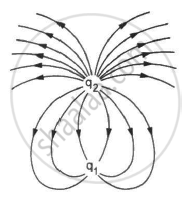Advertisements
Advertisements
प्रश्न
Consider a coin of Example 1.20. It is electrically neutral and contains equal amounts of positive and negative charge of magnitude 34.8 kC. Suppose that these equal charges were concentrated in two point charges seperated by (i) 1 cm `(∼ 1/2 xx "diagonal of the one paisa coin")`, (ii) 100 m (~ length of a long 6 building) and (iii) 106 m (radius of the earth). Find the force on each such point charge in each of the three cases. What do you conclude from these results?
उत्तर
- `F_1 = |q|^2/(4pi ε_0 r_1^2) = (8.99 xx 10^9 (Nm^2)/C^2) ((3.48 xx 10^4 C))/(10^-4 m^2)` = 1.1 × 1023 N
- `F_2/F_1 = r_1^2/r_2^2 = (10^-2 m)^2/(10^2 m)^2` = 10–8 ⇒ F2 = F1 × 10–8 = 1.1 × 1015 N
- `F_3/F_1 = r_1^2/r_3^2 = (10^-2 m)^2/(10^6 m)^2` = 10–16
F3 = 10–16 F1 = 1.1 × 107 N.
APPEARS IN
संबंधित प्रश्न
It is now believed that protons and neutrons (which constitute nuclei of ordinary matter) are themselves built out of more elementary units called quarks. A proton and a neutron consist of three quarks each. Two types of quarks, the so called ‘up’ quark (denoted by u) of charge (+2/3) e, and the ‘down’ quark (denoted by d) of charge (−1/3) e, together with electrons build up ordinary matter. (Quarks of other types have also been found which give rise to different unusual varieties of matter.) Suggest a possible quark composition of a proton and neutron.
Consider the situation shown in the figure. What are the signs of q1 and q2? If the lines are drawn in proportion to the charges, what is the ratio q1/q2?

A point charge is taken from a point A to a point B in an electric field. Does the work done by the electric field depend on the path of the charge?
Choose the correct option.
Two charges of 1.0 C each are placed one meter apart in free space. The force between them will be
A metallic sphere A isolated from ground is charged to +50 μC. This sphere is brought in contact with other isolated metallics sphere B of half the radius of sphere A. The charge on the two-sphere will be now in the ratio
Let x = πR`(("P"^2 - "Q"^2)/2)`, where P, Q and Rare lengths. The physical quantity x is ______.
The number of lines of force that radiate outwards from one coulomb of charge is:-
A glass rod rubbed with silk is used to charge a gold-leaf electroscope and the leaves are observed to diverge. The electroscope thus charged is exposed to X-rays for a short period. Then ______
The dimensions of an atom are of the order of an Angstrom. Thus there must be large electric fields between the protons and electrons. Why, then is the electrostatic field inside a conductor zero?
